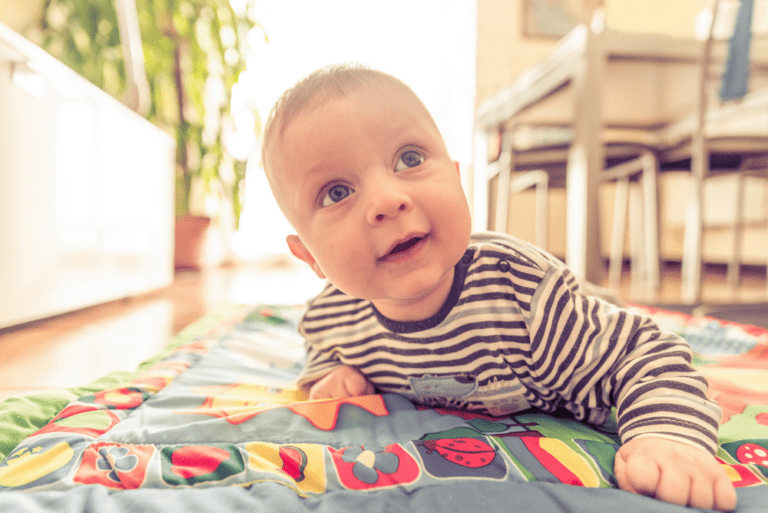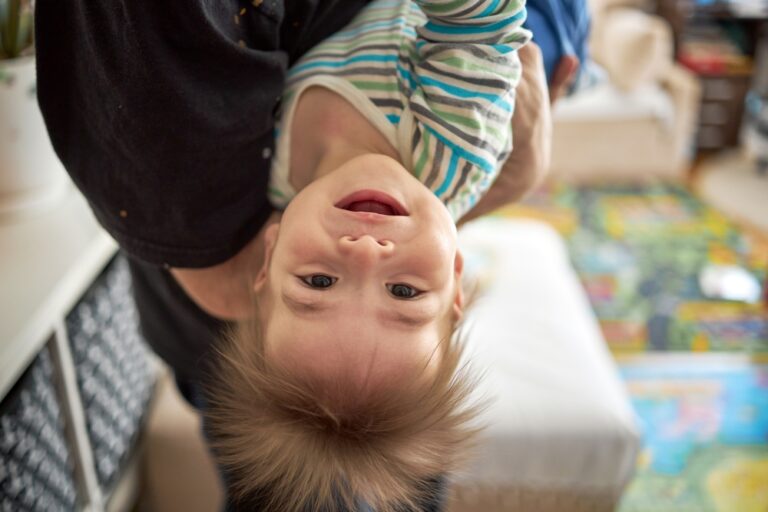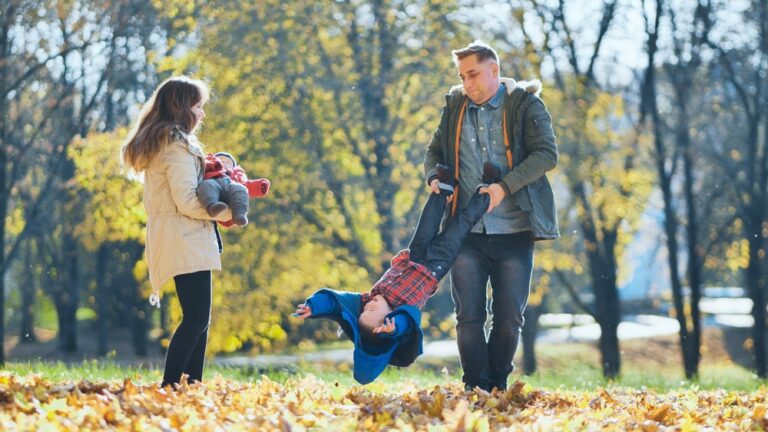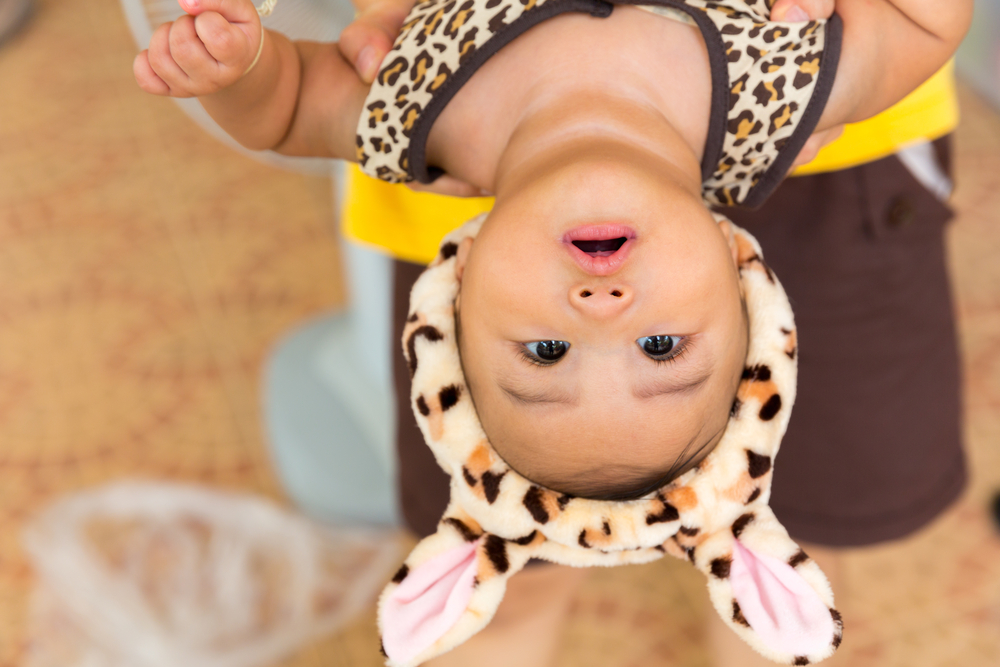Have you ever ever caught your toddler joyfully hanging the other way up, laughing with delight? It’s a sight that may go away any mother or father puzzled but amused. Why does my youngster all the time grasp the other way up? This playful conduct isn’t simply random; it’s a part of their exploration and growth. From the joy of seeing the world in a brand new strategy to the bodily advantages for his or her growing our bodies, this quirky behavior has extra to it than you may suppose.
Let’s dive into why infants love flipping over and what makes this seemingly foolish act important for his or her development and sensory experiences.
Why does my youngster all the time grasp the other way up?
It’s not unusual to see your toddler hanging the other way up. This playful act is usually pushed by curiosity and exploration. Infants are naturally inclined to check their boundaries, and flipping over might really feel like an thrilling journey.
Once they grasp the other way up,
- They expertise a rush of recent views.
- The world appears to be like totally different from this angle, which will be intriguing for tiny explorers.
- This place additionally stimulates the vestibular system, aiding in stability and coordination growth.
- It helps them perceive their physique in relation to gravity.
- You may discover that it brings pleasure; laughter is frequent once they’re flipped round! Their giggles replicate pure delight as they uncover how enjoyable being inverted will be.
So subsequent time you catch your youngster having fun with this exercise, bear in mind: it’s a part of their developmental journey full of surprise and pleasure.

Doable Explanations for Why Infants Get pleasure from Hanging Upside Down
Infants are naturally curious creatures. Their world is full of new sights and sensations, lots of that are finest skilled from totally different angles.
The place stimulates the vestibular system, essential for stability and coordination. This playful inversion will be exhilarating as infants uncover their very own motion talents whereas gaining confidence in how their our bodies work.
Moreover, some infants have an instinctual drive to discover sensory experiences. Upside-down play will be comforting and even enjoyable for little ones who benefit from the feeling of being suspended in area.
It’s additionally value noting that this conduct usually comes from pure pleasure. The laughter and giggles throughout these moments reveal simply how a lot delight infants derive from turning issues on their head—actually!
1. The Vestibular System & Sensory Play
When a child hangs the other way up, their vestibular system, the a part of the interior ear answerable for stability and spatial orientation, will get a exercise.
Dr. Jane Smith, pediatric occupational therapist, explains:
“Inverting their physique helps youngsters develop proprioception (physique consciousness) and calms their nervous system. It’s like a pure sensory remedy!”
This explains why toddlers love toddler doing downward canine or sitting the other way up on sofa. Even newborns profit: whereas do newborns see the other way up? (sure, initially!), their imaginative and prescient adjusts inside weeks, however the vestibular stimulation stays a supply of pleasure.
2. Developmental Milestones & Curiosity
Ever observed your child wanting between their legs? This quirky transfer helps them perceive their physique’s place in area. Hanging the other way up additionally boosts confidence as they conquer gravity, consider it as their first “excessive sport”!
Is Hanging Upside Down a Regular Habits?

Many mother and father surprise, “Is it unhealthy for infants to look the other way up?” The excellent news is {that a} child hanging the other way up is nothing to fret about. It’s frequent for youngsters to experiment with totally different bodily positions as they develop and study extra about their physique’s capabilities.
Many mother and father discover their infants participating in seemingly uncommon behaviors which are a part of common play. So long as the newborn is having fun with the exercise and never inflicting any hurt, it’s seen as a standard stage of their bodily and sensory exploration.
Nevertheless, toddler upside-down actions, like playful hanging, ought to by no means be extended or accomplished in a dangerous atmosphere.
Hanging Upside Down and Autism: Is There a Connection?
Dad and mom might ask whether or not hanging the other way up is an indication of autism. The reply is {that a} child hanging the other way up alone will not be a sign of autism.
Autism spectrum disorder (ASD) is a developmental dysfunction that may have an effect on communication, conduct, and social interactions. Kids with autism exhibit distinctive and repetitive behaviors. Nonetheless, in relation to a child liking to hold the other way up, this conduct is usually not thought of a definitive signal of autism.

Nearer statement could also be required if this motion is coupled with different particular behavioral markers. Indicators of autism often contain:
1. Lack of social interplay
Infants with autism might not have interaction with others in typical methods. For example, they might not make eye contact, smile in response to others, or present curiosity in social video games like peek-a-boo.
2. Repetitive behaviors
Whereas hanging the other way up might be a enjoyable and spontaneous act for a lot of infants, if a toddler constantly engages on this motion rigidly or repetitively, it might point out ASD. Repetitive physique actions, resembling flapping fingers or rocking, are sometimes linked to autism.
3. Sensory Sensitivity
Infants with autism might need heightened sensitivity to sensory enter, and a few might search out intense sensory stimulation, resembling spinning, bouncing, and even hanging the other way up steadily, to self-regulate their sensory expertise.
4. Delayed language and communication expertise
A child who enjoys hanging the other way up however can be experiencing vital delays in babbling, cooing, or different types of communication may exhibit indicators of ASD.
Advantages of Hanging Upside Down for Infants
Hanging the other way up can help childs growth. This playful place stimulates their vestibular system, which performs a necessary function in stability and spatial consciousness.As they grasp the other way up, infants have interaction core muscular tissues, selling energy and coordination. The light inversion encourages blood stream to the top, which will help with cognitive operate and application.

- See the world from new perspective
- observing the world whereas inverted permits them to discover shapes and colours in a different way
- Improves stability and coordination
- Enhances spatial consciousness
- Strengthens core and neck muscular tissues
- Boosts blood circulation
- Supplies sensory enter for youngsters with autism and sensory processing points
Many infants benefit from the thrill of being in such an uncommon posture. It usually elicits laughter and pleasure as they work together with mother and father or caregivers throughout playtime. This connection fosters emotional bonds whereas encouraging bodily exploration by means of motion.
Widespread Issues and Methods to Handle Them
Many mother and father fear once they see their child hanging the other way up. Security is a main concern. Guarantee your toddler has a smooth floor beneath them, like a play mat or carpet. This makes any unintentional falls much less scary.
Different mother and father may surprise if this conduct alerts one thing extra severe, resembling autism. It’s necessary to keep in mind that having fun with inverted positions is frequent for a lot of infants and doesn’t essentially point out developmental points.
In case your youngster appears overly fixated on being the other way up, it could replicate their sensory-seeking nature. Offering alternatives for varied varieties of motion will help stability their want for stimulation with out overwhelming them.
Some infants may expertise discomfort whereas hanging the other way up on account of reflux or gasoline strain. For those who discover indicators of misery throughout these moments, seek the advice of along with your pediatrician for tailor-made recommendation and reassurance about your child’s well being and wellbeing.
How Lengthy Can You Be Upside Down With out Any Hurt?
Whereas hanging the other way up is enjoyable, moderation is vital. How lengthy are you able to safely grasp the other way up? Specialists suggest:

- Infants: Only some seconds throughout light play (by no means unsupervised!).
- Toddlers/Kids: 1-2 minutes max, with breaks.
- Adults: 3-5 minutes for gentle inversions (like yoga).
Warning: What occurs for those who grasp the other way up for two hours? Extended inversion could cause blood strain spikes, dizziness, and even retinal harm. Dr. Emily Ross, pediatrician, warns:
“By no means go away a toddler inverted for quite a lot of minutes. All the time prioritize security over enjoyable.”
For most individuals, hanging the other way up for 1-2 minutes is secure. Nevertheless, staying in an upside-down place for too lengthy can result in dizziness, elevated blood strain, and even fainting.
What Occurs If You Dangle Upside Down for 3 Hours?
If somebody stays the other way up for too lengthy, like 3 hours or extra, they might expertise severe well being dangers, together with:
- Elevated strain on the mind
- Diminished oxygen stream
- Blood pooling within the head
- Potential stroke or cardiac points
When Ought to You Be Involved?
Whereas most infants take pleasure in hanging the other way up purely out of curiosity and enjoyable, there are situations the place you have to be extra observant. Listed below are some conditions the place you might need to search recommendation:
1. Repetitive and Uninterrupted Habits
In case your child insists on being hung the other way up steadily and turns into distressed in the event that they’re not in that place, it might point out a necessity for self-regulation or sensory stimulation that could be value exploring additional.
2. Accompanying Developmental Delays
It might sign an underlying problem in case your child enjoys hanging the other way up however exhibits bodily, social, or verbal developmental delays.
3. Unresponsiveness to Social Cues
Infants with autism usually present diminished curiosity in social interplay. In case your youngster appears bored with connecting with others or exhibits an absence of responsiveness to social stimuli, this, mixed with repetitive behaviors, might elevate considerations.
Suggestions for Safely Incorporating Inverted Play into Child’s Routine
Making a secure atmosphere for inverted play is crucial. Begin by guaranteeing the world is freed from sharp objects or hazards that might hurt your child throughout their playful antics.
Use smooth surfaces, like carpets or mats, to cushion any falls. It will assist cut back concern and encourage exploration. A mild grip round their waist can present safety as you maintain them the other way up.
Introduce brief periods at first; infants can rapidly turn into overstimulated. Look ahead to indicators of discomfort or fatigue, and be prepared to change actions if wanted.
Incorporate hanging moments into day by day routines, resembling throughout diaper adjustments or playtime with colourful toys overhead. This provides a component of enjoyable whereas selling growth in stability and coordination.
All the time supervise intently to make sure security stays a high precedence as they discover being the other way up in new methods.
Participating Actions for Totally different Child Phases
I’ve listed down participating actions for infants at totally different phases. Infants at totally different ages require diversified stimulation to help their development. Listed below are some child actions for various phases that align with their developmental wants:
| Child Age | Participating Actions |
|---|---|
| 3-Month-Previous | • Light tummy time • Laying on their again • Sensory exploration with smooth toys • Occasional upside-down play whereas mendacity on a mother or father’s lap |
| 5-Month-Previous | • Light upside-down play (lifting child whereas supporting neck and head) • Object grabbing and head management workout routines |
| 8-Month-Previous | • Rolling round • Sitting up • Hanging head the other way up off furnishings (supervised) • Introduction to stability by means of upside-down play |
| 10-Month-Previous |
• Crawling
|
Enjoyable Methods to Dangle Upside Down Safely
Wish to take pleasure in the advantages of hanging the other way up with out dangers? Listed below are some secure and enjoyable methods:
1. Utilizing a Dangle Upside Down Chair
These specifically designed chairs help you recline and revel in delicate inversion remedy.
2. Hanging Upside Down Equipment
Gadgets like inversion tables and aerial yoga hammocks present managed inversion advantages.
3. Mendacity Upside Down on a Sofa
Sitting the other way up on a sofa or letting your head grasp off the sting is an easy strategy to expertise delicate inversion.
4. Upside Down Remedy
Some remedy facilities provide upside remedy of their present location to assist with spinal decompression and blood circulation.
FAQ’s
1. Why is my child doing the downward canine place?
Infants do the downward canine place to strengthen muscular tissues and discover motion, usually earlier than crawling. It’s a standard developmental stage.
2. Why does my child flip the other way up?
Infants flip the other way up to discover their vestibular sense (stability), strengthen muscular tissues, and fulfill their curiosity about totally different views.
3. Do autistic youngsters like being the other way up?
Some autistic youngsters take pleasure in being the other way up as a type of vestibular stimming, offering sensory enter they discover calming or stimulating. It’s not true for all autistic youngsters, and plenty of neurotypical youngsters additionally take pleasure in it.
4. Is hanging good for infants?
Supervised, transient hanging will be good for infants to develop grip and higher physique energy. It should all the time be accomplished safely with grownup help.
5. How are you aware your youngster isn’t autistic?
You possibly can’t definitively “know” with no skilled analysis if in case you have considerations. Typical indicators a toddler is probably not autistic embrace constant eye contact, responding to their title, and typical language and social growth.
6. What’s vestibular stimming?
Vestibular stimming is repetitive motion (like spinning, rocking, or being the other way up) that gives sensory enter to the stability system. It’s usually used for self-regulation, particularly by these with sensory processing variations.
7. What’s a sensory seeker?
A sensory seeker is somebody whose mind craves extra intense or frequent sensory enter than typical. They actively search experiences like loud noises, sturdy flavors, or plenty of motion.
8. Why does my child grasp low?
In case your child appears floppy or has hassle holding their head up, “hanging low” might point out low muscle tone; seek the advice of your pediatrician. In any other case, in the event that they’re simply relaxed whereas exploring, it’s doubtless regular.
9. Why is my child wanting the other way up?
Infants look the other way up out of curiosity, to expertise new visible views, and for distinctive enter to their growing stability system.
10. Why does my child need to grasp the other way up?
Your child needs to hold the other way up to develop their vestibular sense, strengthen muscular tissues, and benefit from the stimulating sensation of a special view.
11. Why do infants flip the other way up?
Infants flip the other way up to develop their stability system, construct energy, and discover the world and their physique from new angles.
12. Why does my youngster all the time grasp the other way up?
In case your youngster constantly hangs the other way up, they might be a sensory seeker for vestibular enter, discovering it regulating or gratifying. So long as it’s secure, it’s usually fantastic.
13. Is it good for teenagers to hold the other way up?
Sure, sparsely and safely, it’s good for teenagers to hold the other way up. It aids vestibular growth, builds core and higher physique energy, and improves spatial consciousness.












